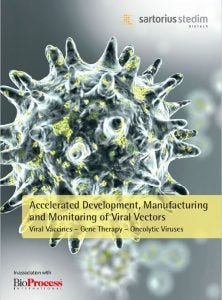- Sponsored Content
- Gene Therapies
- Risk Management
- Single Use
Accelerated Development, Manufacturing and Monitoring of Viral Vectors
August 29, 2018
Sponsored by Sartorius
 The goals of process intensification are to enhance production while shortening timelines, lessening contamination and environmental risks to products and operators, and reducing operating footprints. Previous publications from Sartorius Stedim Biotech (SSB) have highlighted key elements of such activities. In this report, the authors extend the scope of this discussion to tools and technologies that enable intensification of viral vector manufacturing processes.
The goals of process intensification are to enhance production while shortening timelines, lessening contamination and environmental risks to products and operators, and reducing operating footprints. Previous publications from Sartorius Stedim Biotech (SSB) have highlighted key elements of such activities. In this report, the authors extend the scope of this discussion to tools and technologies that enable intensification of viral vector manufacturing processes.
The first article summarizes presentations from a 2018 seminar for viral vaccine manufacturers. Three guest presentations highlighted the need to
intensify viral vector production: a labor-intensive process for which the high titers and vector quantities needed demand careful process
optimization. Building on its platform of single-use technologies, Sartorius offers tools and technologies to reduce capital costs and decrease the consumption of energy and water during vaccine production.
Vaccines, however, are too diverse a product category for a single platform approach to address all of the challenges. In the next article on predefined platform technologies, Amélie Boulais describes how predefined technologies can be integrated with one another to enable development and manufacturing of vaccines. She offers examples of upstream and downstream processing technologies that viral vector manufacturers can use within their processes.
Even established multinational pharmaceutical companies often do not have the capabilities and/or expertise to manufacture viral vectors that are large (>0.2 μm) or replicating or both, especially at industrial-scale batch sizes. A significant endorsement of SSB’s platform for viral vector processing and single-use design, the ABL facility described in the third article offers capacity designed to help in the manufacture of viral vectors for a wide range of applications such as oncolytic, vaccines, and gene therapy products.
None of this work can ignore continuing needs for both safety and processing flexibility. The fourth article explores risk factors in viral vector production with single-use components. The authors discuss preventing bag ruptures and filter blockages, along with ways to ensure robustness of processing equipment against long-term working pressures and temperatures. Operator safety should be a significant concern in selection of a single-use technology for vaccine manufacturing. The authors conclude with the importance of challenging single-use bioreactor vendors on their approaches to biosafety risk mitigation to allow a company to make well-founded decisions regarding its future bioreactor platform.
Contents
Viral Vector Development, Manufacturing, and Process Intensification
Miriam Monge, Amélie Boulais, and Gerben Zijlstra
Single-Use Platforms Accelerate Viral Vaccine Development and Manufacturing
Amélie Boulais
GMP Manufacturing Facility for Viral Vector Production at ABL Europe
Amélie Boulais and Nick Hutchinson
Biosafety Considerations for Single-Use Bioreactors
Davy De Wilde, Joerg Weyand, Ute Husemann, Bernward Husemann, and Gerhard Greller
Just fill out the form to view and download the complete eBook.
You May Also Like





